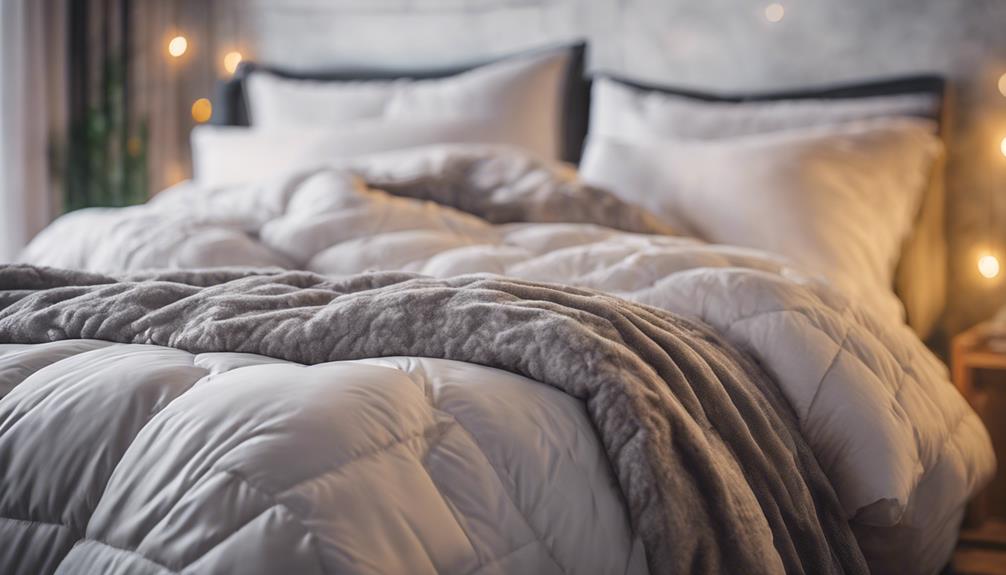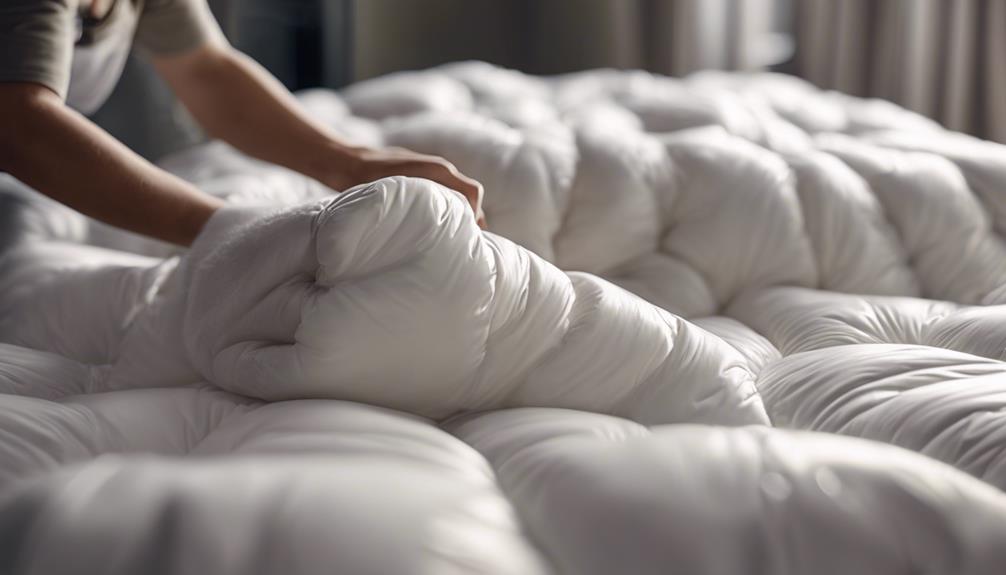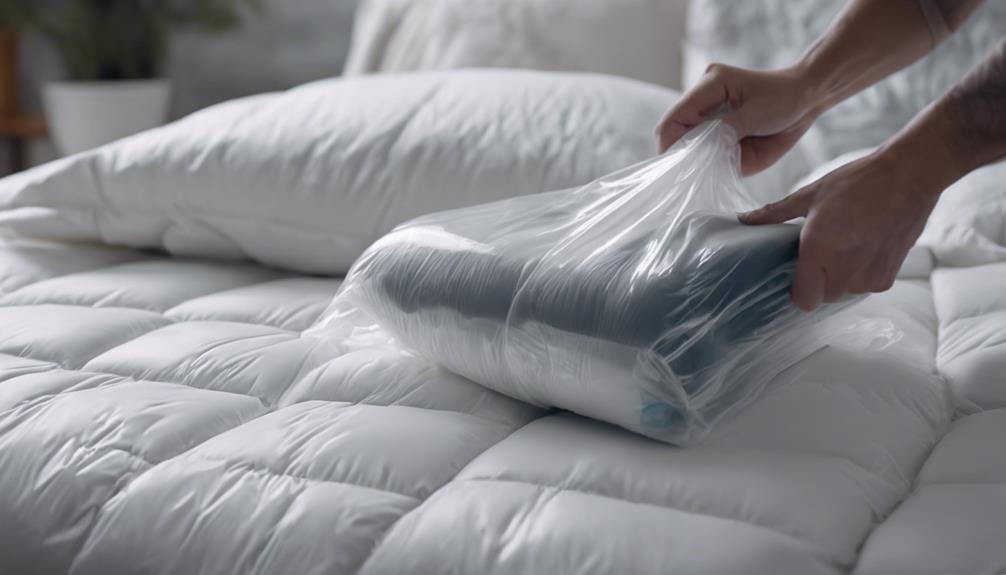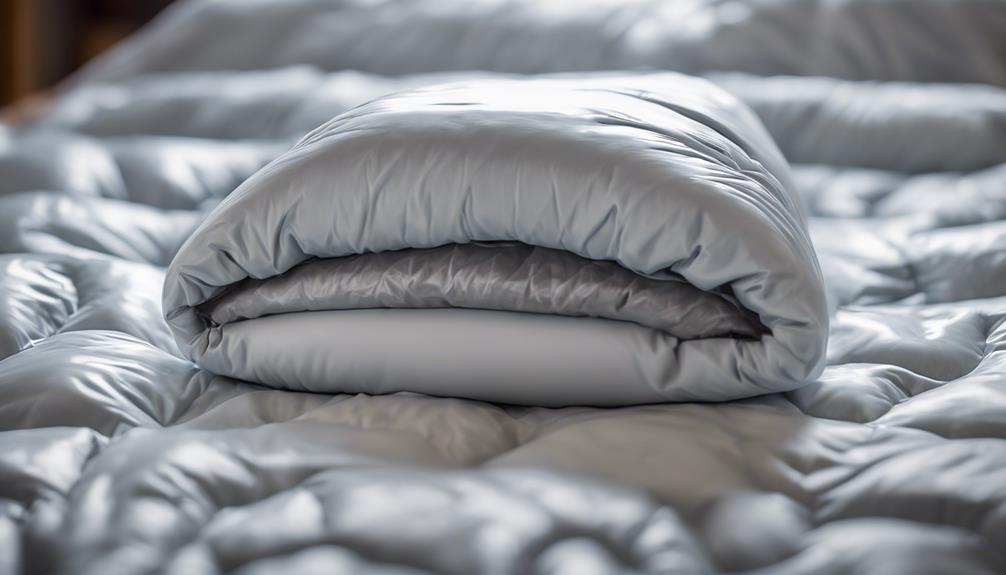Introducing a comforter to your child can improve their sense of security, emotional well-being, and self-soothing capabilities. It establishes a positive bedtime routine and fosters a peaceful sleep environment. Comforters act as emotional support blankets, promoting a sense of belonging and attachment. They help in emotional development, manage emotions effectively, and support a positive sleep association. Choosing the right comforter, introducing it at around 7 months, and being patient and consistent are key. Comforters provide stability, attachment, and emotional support for overall well-being. They assist children in self-soothing, regulating emotions, and managing separation anxiety. Further insights await.
Key Takeaways
- Enhances sense of security and emotional well-being for babies.
- Aids in self-soothing during night wakings and separation anxiety.
- Creates a positive bedtime ritual and promotes peaceful sleep.
- Acts as an emotional support blanket fostering attachment.
- Supports emotional development and provides comfort for better sleep.
Benefits of Using a Comforter

Using a comforter can greatly enhance a baby's sense of security and emotional well-being during sleep. This simple item isn't just a soft material; it serves as a source of comfort for babies, providing emotional support and reassurance.
When babies have their comforter with them, they feel a familiar connection that helps them self-soothe during night wakings, establishing better sleep habits. The comforter becomes a trusted companion, aiding children through phases of separation anxiety and offering comfort in various situations.
By introducing a comforter to a baby's sleep routine, parents can create a positive bedtime ritual that eases changes and promotes a peaceful environment for sleep. The comforter's presence creates a sense of familiarity and security for babies, ultimately contributing to their overall well-being.
As caregivers, it's essential to recognize the significant role a comforter plays in providing comfort and emotional support to our little ones.
Comforter as a Source of Security
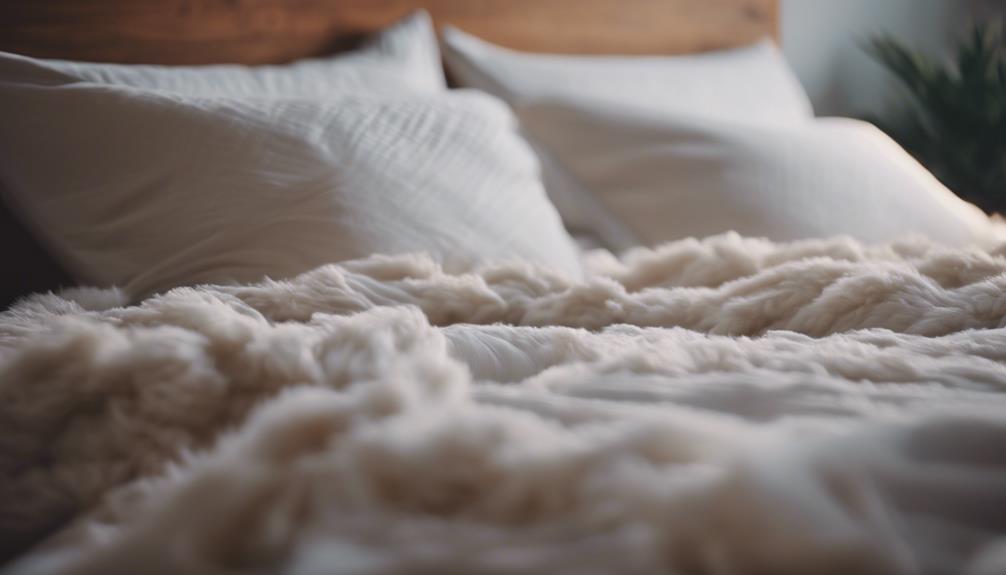
Comforters act as an emotional support blanket for babies, providing them with a sense of security and comfort.
By introducing a comforter, we can help our little ones feel a sense of belonging and attachment, fostering a peaceful sleep environment.
This source of security can aid in their emotional development and help them navigate new or challenging situations with ease.
Emotional Support Blanket
During times of stress or change, an emotional support blanket, like a comforter, can provide a source of security and comfort for babies, aiding in building a sense of attachment and promoting self-soothing abilities.
This comfort item acts as an emotional support system, creating a positive sleep association that's safe for babies. It can help your baby feel secure and calm, fostering a sense of familiarity and reassurance.
By introducing a comforter, you're giving your baby a tool to self-soothe and manage their emotions effectively. This promotes stability and a feeling of safety, especially during adjustments or challenging moments.
Utilizing a comforter can also contribute to establishing a positive bedtime routine, ensuring your baby feels comforted and secure as they drift off to sleep.
Sense of Belonging
In moments of uncertainty, a comforter becomes a steadfast source of security and belonging for babies, offering them a sense of safety and comfort.
Introducing a comforter can help babies establish a healthy attachment, aiding in their emotional development and self-soothing abilities.
The presence of a comforter provides a familiar and reassuring connection for babies, promoting feelings of security in various environments.
This sense of belonging helps babies feel connected and supported, especially during times of distress.
By incorporating a comforter into their routine, babies can develop a positive sleep association, making bedtime and nap times more settling and predictable.
This security blanket serves as a comforting companion, fostering a sense of safety and comfort essential for the overall well-being of babies.
Peaceful Sleep Environment
Creating a peaceful sleep environment for babies, a comforter serves as a reliable source of security and familiarity. The presence of a comforter can help babies associate sleep time with comfort, establishing a soothing bedtime routine.
When a comforter is nearby, babies can self-soothe during night awakenings, leading to more restful sleep for both baby and parents. This sense of security provided by the comforter acts as emotional support, helping babies feel secure and settled, especially in new or challenging situations.
Comforter for Emotional Development

Comforters play an essential role in emotional development by offering babies a sense of security and comfort.
They help infants self-soothe in times of distress, aiding in the cultivation of emotional resilience.
Emotional Support Benefits
Encouraging emotional well-being, a comforter plays an essential role in nurturing a child's sense of security and attachment. By providing emotional support, comforters help babies develop a strong foundation for their emotional development.
The presence of a comforter can assist in building self-soothing skills, enabling children to regulate their emotions effectively. This sense of security and attachment to a comforter aids in managing separation anxiety and moving through changes smoothly.
Establishing a bond with a comforter fosters emotional resilience and promotes feelings of safety and comfort in children. Through the comforter's consistent presence and comforting touch, children can experience a sense of security that contributes to their overall emotional well-being.
Comforter for Well-being
In nurturing a child's emotional development, the presence of a comforter plays a crucial role by providing a sense of security and comfort. Here are some key ways in which a comforter contributes to emotional well-being:
- Security: Comforters help create a safe environment for babies to explore their emotions.
- Self-Soothe: They assist babies in managing their feelings and soothing themselves during times of distress.
- Attachment: Building a bond with a comforter promotes healthy attachment patterns and emotional stability.
- Emotional Connection: Comforters offer familiarity and emotional support, fostering a strong connection with the baby.
- Reassurance: Using a comforter can reassure babies, making them feel secure and aiding in their emotional development.
Introducing Comforter for Self-Soothing

When introducing a comforter for self-soothing, parents can help their babies learn to independently soothe themselves for better sleep habits. This process assists in establishing a positive sleep association and aids in bedtime routines and changes. Comforters can become security items for babies, especially during times of separation anxiety or distress. Choosing a breathable and safe comforter around 7 months of age can support babies in developing self-soothing skills effectively. Consistency and patience play vital roles in this process, as babies gradually build a connection with their comforters. Below is a table highlighting the key benefits of introducing a comforter for self-soothing:
| Benefits of Introducing a Comforter for Self-Soothing |
|---|
| Helps babies self-soothe independently |
| Establishes positive sleep association |
| Provides security during separation anxiety |
Introducing a comforter at the right time and with the right approach can significantly contribute to a baby's well-being and sleep routine.
Comforter for Bedtime Routine
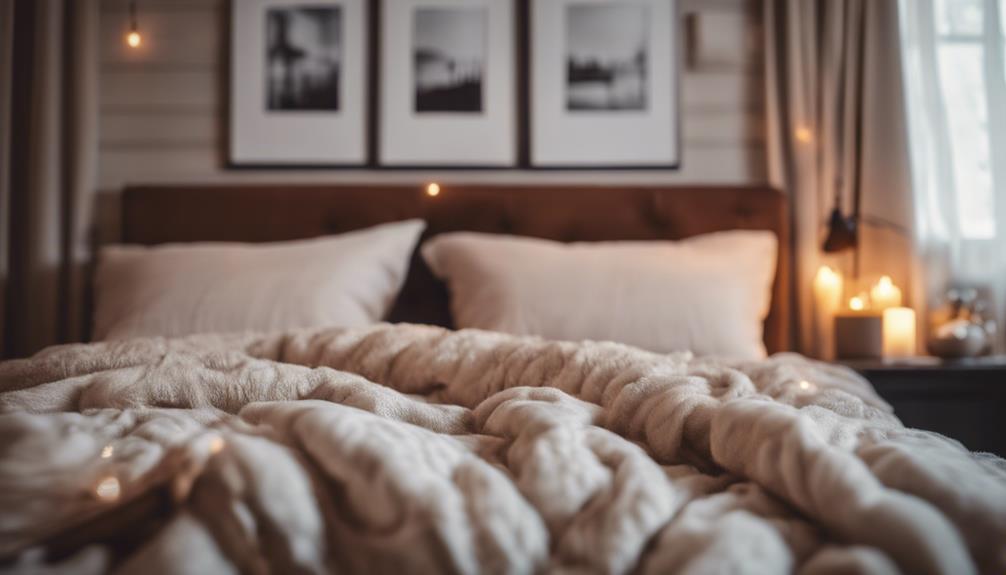
We find that introducing a comforter into the bedtime routine can create a sense of safety and security for babies. Incorporating a comforter into the bedtime routine is beneficial for establishing a positive bedtime routine.
Here are five reasons why a comforter can enhance your baby's bedtime experience:
- Signal bedtime: A comforter can act as a cue that it's time for sleep, helping babies understand when it's time to rest.
- Create safety and security: The presence of a familiar comforter can provide a feeling of safety and security, soothing babies as they prepare for sleep.
- Aid in self-soothing: Babies can learn to self-soothe by cuddling with their comforter, promoting independent sleep habits.
- Comfort and familiarity: The comforter offers a sense of comfort and familiarity, making bedtime adjustments smoother and more calming.
- Better settling and sleep: By incorporating a comforter into the bedtime routine, babies are more likely to settle down and sleep better throughout the night.
Choosing the Right Comforter

Considering your baby's comfort and sensory needs, selecting a suitable comforter made from breathable fabrics like cotton, muslin, or silk is crucial for promoting a restful bedtime routine. When choosing the right comforter, it's important to bear in mind that this item can become a long-term attachment for your baby, providing them with a sense of security and comfort. Look for features that appeal to your baby, such as satin tags for sensory stimulation, and make sure the comforter is machine-washable for easy cleaning and maintenance.
Opting for a soft toy that doubles as a comforter can help soothe your baby to fall asleep, making it a valuable addition to their safe sleep environment. Additionally, having the comforter in the cot with your baby can provide them with a familiar and comforting presence throughout the night. Consider selecting a comforter that offers the option to attach a dummy if needed, offering extra soothing benefits for your little one. By selecting the right comforter, you can enhance your baby's sleep experience and promote a sense of security during bedtime.
Tips for Successful Comforter Introduction
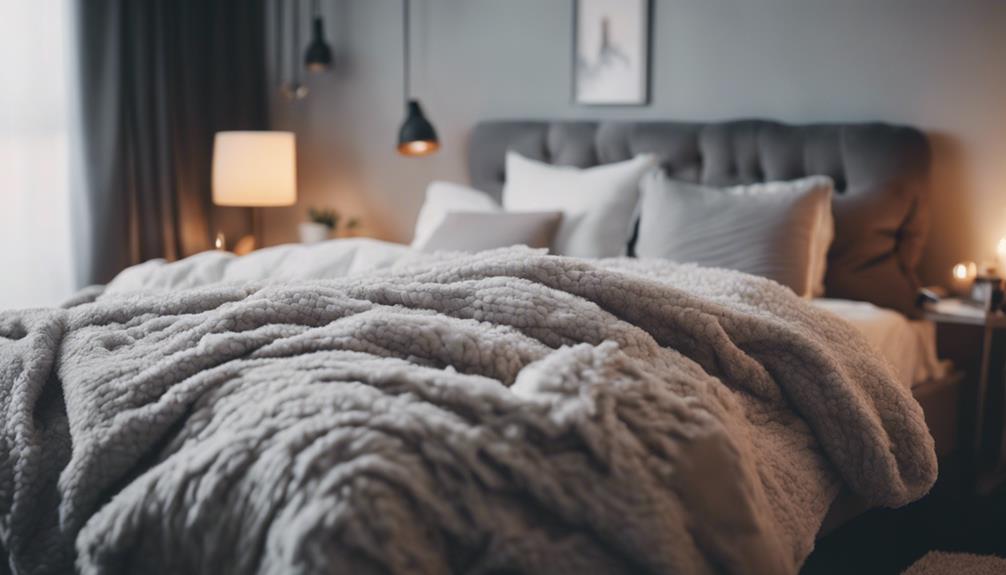
To successfully introduce a comforter to your baby, start by choosing a breathable and safe option that promotes comfort and security. When introducing a comforter to your little one, consider the following tips for a successful shift:
- Establish Positive Sleep Association: Introduce the comforter around 7 months to create a positive association with sleep.
- Choose Safe Comforter: Opt for a comfortable and safe comforter that meets all safety standards for your baby's well-being.
- Transfer Scent to Comforter: Make the comforter familiar by sleeping with it to transfer your scent, providing comfort to your baby.
- Use During Feeds and Wind-downs: Incorporate the comforter during feeding and calming routines to associate it with comfort and relaxation.
- Patience and Consistency: Be patient and consistent in using the comforter to help your baby settle and find comfort effectively.
Comforter Attachment and Stability
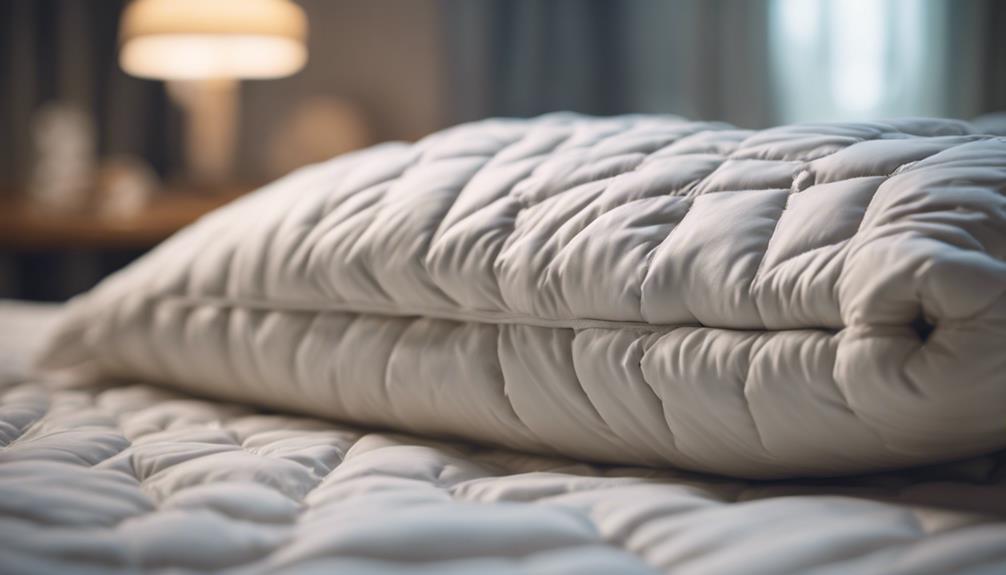
Comforters play an essential role in providing emotional stability and security for babies during times of distress. Attachment to a comforter can help babies self-soothe and manage their emotions effectively. By introducing a comforter around 7 months of age, parents can aid in establishing a positive sleep association, which can benefit the child's bedtime routine. Comforters offer a source of familiarity and comfort for babies during changes or new situations, providing them with a sense of security and comfort.
Children often develop a healthy attachment to their comforter, which promotes feelings of safety and security. This attachment can serve as a source of emotional stability for the child, helping them navigate through challenging moments. Encouraging the bond between the child and their comforter can lead to a sense of reassurance and comfort, ultimately supporting the child's overall well-being and emotional development.
Supporting Child's Emotional Development

Supporting a child's emotional development involves fostering a sense of security and comfort through the introduction of a reliable source of reassurance. When it comes to emotional development, incorporating a comforter can have various positive impacts on a child's well-being:
- Self-Soothe: Comforters help children learn to self-soothe and regulate their emotions independently.
- Positive Sleep Association: Using a comforter can establish a positive connection with sleep, aiding in bedtime routines and promoting better sleep quality.
- Separation Anxiety: Comforters can be especially beneficial during phases of separation anxiety, offering children a sense of security and reassurance in their parent's absence.
- Sense of Familiarity: Through attachment to a comforter, children develop a sense of familiarity and emotional support, which contributes to their overall resilience.
- Emotional Support: Comforters provide emotional support, helping children feel safe and comforted in various situations, ultimately aiding in their emotional growth and stability.
Frequently Asked Questions
What Are the Benefits of Introducing a Comforter?
Introducing a comforter offers multiple benefits for babies. It helps them feel secure and calm during sleep, promoting better rest and reducing night waking. Comforters assist in self-soothing and can ease separation anxiety.
Establishing a positive bedtime routine with a comforter aids in smooth changes. Children can develop healthy attachments to their comforter, enhancing emotional well-being and security.
When Should I Introduce a Comforter to My Baby?
Between 7 and 10 months, we should introduce a comforter to our baby. This age range aligns with recommendations to promote comfort and connection.
When choosing a comforter, opt for breathable fabrics like cotton, muslin, or silk. Make sure to check the comforter's age suitability before introducing it to your little one.
Doing so at the right age can aid in settling and providing comfort for your baby.
Why Are Comforters Important for Children?
Comforters are essential for children as they offer security and comfort in new or unsettling situations. They aid in self-soothing during distress, promoting emotional regulation and smooth changes. By forming healthy attachments to their comforter, children enhance their emotional development.
Comforters help children sleep better, reducing night wakings and fostering good sleep habits. Overall, comforters play a significant role in providing comfort, security, and emotional support for children.
How Do You Encourage a Comforter?
When encouraging a comforter, start by introducing it during feeding times for comfort and security. Transfer your scent by sleeping with it to create familiarity.
Use it during playtime and bedtime for positive associations with sleep. Tuck it in with your baby at 7 months for self-soothing.
Consistent use helps form strong attachments. It's key for security during changes and bedtime.
Our little ones will truly cherish their comforters through these simple steps.
Are Polyester Comforters Better for Allergies than Other Materials?
Many people find that polyester comforters are better for allergies than other materials for reasons for polyester comforters. Polyester is hypoallergenic and is resistant to dust mites and mildew, making it a great option for those with allergies. Additionally, it can be easily washed and dried, minimizing allergen buildup.
Conclusion
To sum up, introducing a comforter to your child can provide numerous benefits, from promoting a sense of security to aiding in emotional development and self-soothing.
By choosing the right comforter and following tips for successful introduction, you can help support your child's emotional well-being and stability.
Remember, the comforter can become an essential part of your child's bedtime routine, offering comfort and reassurance in times of need.



